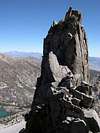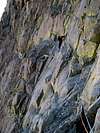|
|
Route |
|---|---|
|
|
37.10970°N / 118.4917°W |
|
|
Technical Rock Climb |
|
|
Most of a day |
|
|
5.7 IV |
|
|
Approach
Start from the Glacier Lodge trailhead and follow the North Fork trail up to Third Lake. From Third Lake, head up to the base of the Temple Crag. Approach M.G.A by hiking up moderately steep snow, up the obvious coulior. Half way up, swing left over to the base of a large blocky slab section (locally known as the Death Traverse).
Route Description
The route starts by ascending the snowfield between Moon Goddess Arete and Sun Ribbon Arete (hard snow conditions in morning hours.....even in August) to reach left trending ledges (class 3-4). One stradegy to reach the ledges safely is to kick steps in the snow up to the start of the route the day before and stash gear. Once there, most will want to rope up once on the ledges. Move left along ledges (~200 feet), and scramble up the low angle arete starting on left side of ledges. Climb roughly 6 pitches of mostly class 4 stuff (with some low 5th moves sprinkled in) to the base of the First Tower ("base" meaning about 30-40 feet below its summit). These first half dozen pitches can be simul climbed before reaching the more technical pitches above.
Once at the tower, traverse it's right side (5.7). Once past the traverse, downclimb about 15 feet and belay at a notch between the tower and the next pitch. CAUTION: rope-eating grooves makes for some horrible drag on this pitch.
Belay at a spacious ledge across from the notch, near the base of an alcove. Climb the next pitch up a green lichen covered wide "chimney/corner" (5.7). It looks loose from afar but is not that bad once you're there.
Climb the "chimney/corner" to reach a short left facing dihedral (@ 20 feet in length). Continue the pitch up this dihedral. This is probably the crux of the route (5.8......short and not really that sustained). Belay on a ledge, signatured with white marble (about 3 feet by 10 feet). You're now at the base of Ibrium Tower.
The next pitch heads up the face of the tower (find easiest/most protectable line) for 20 feet and then traverses to the right edge of the tower's face and around the corner. Follow easy and ledgy terrain on right side of corner (of Ibrium Tower) to a decent belay stance (topmost "ledge"). I don't think climbing here was harder than 5.6. An alternative option is to head straight up the face of Ibrium Tower (5.9...scary loose blocks!)
Next pitch starts with a 20 foot downclimb (class 4) onto a narrow (class 3-4) ledge system that trends along the right hand side of Ibrium Tower. Traverse this ledge system (going is never harder than class 4) for about 160-180 feet. Belay BEFORE you reach the foot of a minor arete (with a large nice flat ledge at its foot).
Start the next pitch by turning left and up the back side of the Ibium Tower (a 5.7 wide gully). DO NOT climb the "minor arete" next to the "gully". As a sight reference. there is a huge, flat chockstone atop the ridge (looks like a diving board). This signatures the end of this pitch (@ 180 feet).
From the top of flat chockstone, climb up the right side of the next step in the arete. There are 3 pitons at the start of this pitch (5.7). Once you top out on this "step" (180 feet), locate slings with rap rings for the next pitch and belay here.
Continue the next pitch by doing a short rap (@ 20 feet) or downclimb what looks like 5.7 terrain into a notch at the foot of yet another "step" in the ridge. Climb up a steep exposed crack on left side of this step (large gear: #3 Camelots/#8 Trango Flex Cam). The going is 5.7+/5.8- with a few lieback moves halfway up the "step". CAUTION: there are a few loose rocks/chockstones (one that looks like a sword) in this crack that move a bit. Belay atop the step.
The final pitch is a short 50-foot crack at a headwall (5.6). Climb the crack to reach the class 2-3 talus slopes.
THE DESCENT:
Hike down the back side of Temple Crag to Contact Pass. Cairns mark the descent to rap slings with rap rings (exposed 3rd class). Rap 100 feet to the pass or down climb a wild 4th class crack. Hikme down snow slopes next ot the base of Temple Crag and onward to Third Lake (if that's where your bivy is).
Essential Gear
Again, attack the snow in the morning (a glacier axe can be helpful). Bring a good amount of slings (for going around towers or in case you have to bail.....thunderstorms...hint,hint). Cams (pro to #3 Camelot) Nuts and hexes do just fine as well. Emphasis on tiny and some large pro (mainly on the upper pitches).
Care And Caution
Moon Goddess Arete' has been the subject of a few accidents, as has been the case also with its next door neighbor, 'Venusian Blind' . Both resulted in the deaths of climbers. Its upper pitches are somewhat loose and exfoliating. Use extra caution in the following spots along the route: Behind the first gendarme encountered (loose scree and rocks in the notch with lots of exposure on each side!), while traversing around to the right side of the Ibrium Tower (scene of the Sept '02 accident......lots of loose rock and scree), several loose blocks straight up the Ibreum Tower (5.9) and the small blocky towers near the summit.








Eric O - Aug 12, 2005 12:43 am - Hasn't voted
Route CommentSome people do the traverse of the "death traverse" ledges at a higher altitude than necessary, going maybe 10/20/30 feet too high. This gets you into more difficult terrain around the corner, when you don't really have to.
Seems like it happens either due to the climber's instinct to gain altitude wherever possible, or because people are naturally scared of walking too close to the cliff edge below. Either way, if you do the traverse at a level that's just a short distance above the cliff, it's easy 3rd class. It may look scarier down there, but it has no real 4th class moves. So maybe it's 4th just by reason of exposure, but in a difficulty sense the moves are 3rd and even 2nd much of the time (i.e. ledge walking using hands only for balance). Just don't slip on sand or gravel or moss.
Then once you get around the corner, there's no need to head upward immediately; if you keep traversing left/south a bit longer, an easy 3rd/4th class ledge system appears, and this takes you up to Venusian and Moon Goddess on positive holds.
Eric O - Aug 12, 2005 1:04 am - Hasn't voted
Route CommentI don't mean to be picky, but I noticed the route description has IV 5.7 in the heading, but then refers to 5.8 sections in the description text below.
Soloing the Moon Goddess today I was definitely choosing the easiest ways through, never doing anything harder than necessary, and I'd have to say it did get to 5.8 in two or three places. Never for more than a couple of moves in a row, but it did reach 5.8.
A 5.8 rating would also be consistent with Croft and I don't know who else. Moynier/Fiddler have it as 5.7 (at least in the older edition), but then they also rate the traverse to skirt the first tower as 5.4.
fossana - Aug 16, 2009 9:59 am - Voted 10/10
notesThe downclimb just before the second to the last pitch is short, more like 10-12 ft. Otherwise the route description is on target from a route-finding standpoint (can't speak to rope length). Having soloed both Venusian and Moon Goddess within the last 13 months I can't say that the rock is any more sketchy than on other Sierra routes like the T-bolt to Sill traverse. IMHO, Moon Goddess was significantly more exposed than Venusian and much more fun.